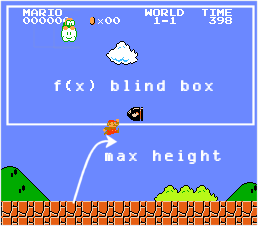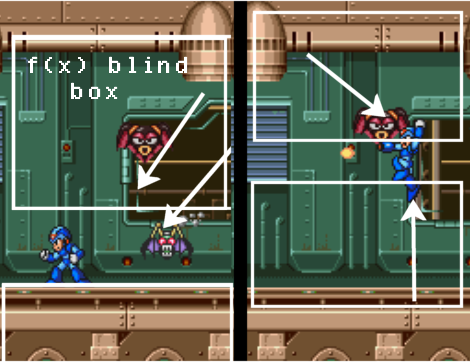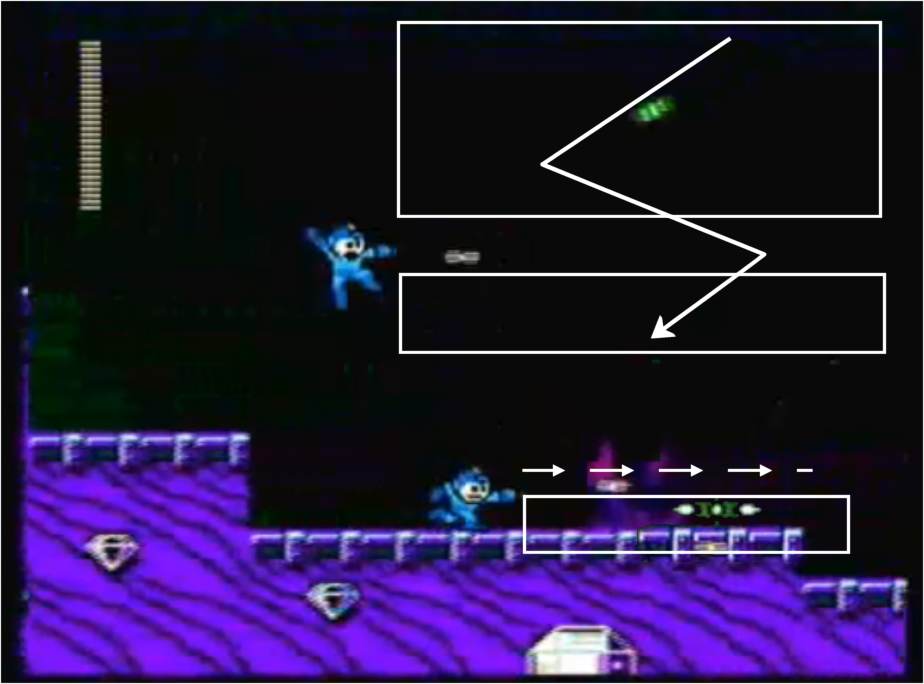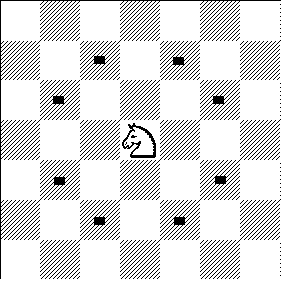Counterpoint: Functional Blind Spots
 Friday, March 27, 2009 at 11:04PM
Friday, March 27, 2009 at 11:04PM A functional blind spot is a space in a video game relative to the player that is difficult to interact with due to a combination of the player's mechanics/abilities and the level design (arrangement of level/enemy elements). A functional blind spot is very different from a perspective blind spot. Perspective blind spots are created from a lack of a clear view of a situation. Due to the nature of 3D, viewing a 3D environment or object from any fixed perspective creates perspective blind spots. This is an inherent quality of 3D spaces that we're all used to. However, a functional blind spot has nothing to do with perspective and everything to do with design. In fact, functional blind spots usually occur when the player has a complete view of a game space.
When enemies are designed to create contrary motion within functional blind spots, the result are usually pretty similar. Functional blind spot enemies are always annoying, tricky, and/or dangerous. For these enemies, it's not that they do a lot of damage or attack in great numbers. Simply existing in these awkward, almost non interactive spaces is enough to make players feel like they're powerless thus creating a high amounts of tension. The best part of designing such enemies is that what makes them more unique and threatening than normal enemies is the dynamics of space whether 2D side scrolling, top down, or 3D.
Functional Blind Spots matter most when used to design enemy or level elements for the purpose of creating contrary motion and tension. In other words, functional blind spots are designed around the player character, shaped through stage design, and accented using enemy design. In this way, recognizing and understanding an example of a functional blind spot requires a thorough understanding of a gameplay scenario based on several design layers. This in itself makes functional blind spots an advance subject under counterpoint.
The best way to understand functional blind spots is through examples.

- Lakitu, Bullet Bills, and Bloopers: Super Mario Brothers. Lakitu hangs out at the top of the screen at an altitude that is much higher than Mario can reach from the ground. Without any blocks nearby to platform off of, Mario can't reach this enemy that pressures the situation by throwing Spiny enemies down to the ground.
- In the same way, a Bullet Bill traveling at a height just above Mario's maximum JUMP height is one of the most dangerous zones for a Bullet Bill to travel in. At that height Mario can't jump on top of the Bullet Bill from the ground to eliminate it. Therefore, the Bullet Bill functions as a platforming threat.
- Like underwater Mario, Bloopers can move quickly going up, horizontally, and float downward slowly. Without the fire flower powerup, Mario cannot defeat enemies underwater. Maneuvering around these enemies can be very complicated. Mario's vertical and horizontal speed/control are diminished underwater. This, in addition to the Blooper's ability to move through level elements and follow Mario, can easily create dangerous traps. Even with the fire flower power up, if the Bloopers approach above Mario, he's still in trouble.

- Bats: Mega Man X. These enemies fly at about a 45 degree angle toward Mega Man. Because Mega Man can only fire straight ahead of him and he can only jump so high, these flying enemies exist right inside a functional blind spot. Players often back up or circle around these enemies in attempt to force the bats to drop down low enough so they can be shot. With the right kind of level design, these slow moving enemies can become a terror. Notice in the image above how the blind spots/boxes are relative to Mega Man's position.

- Bats, the Ghost, and Shopkeepers: Spelunky. The bats in Spelunky are nearly identical to the bats in Mega Man X. They hang upside from the ceiling and drop down flying at a 45 degree angle when approached. If you don't have a rock or some other object to throw up at it, these enemies can really force you to back up until you can WHIP it at a safe distance.
- In the same way that the Bloopers can become quite dangerous when they pass through walls and other level elements, the Ghost that sometimes appears in Spelunky is hindered by nothing. The only strategy for dealing with this spirit is to run away. The way it moves through space ignoring solid level elements makes it hard to deal with.
- The Shopkeeper may be easily upset and he may wield a dangerous shot gun, but even enemies have blind spots. Fortunately for all of us law breaking cave divers, Shopkeepers have a huge blind spot directly above their heads. If you throw a rope up and drop a bomb from the top of his shop, he won't be able to harm you. Or, if you manage to trap him in a web, you can JUMP on his head until he falls.

- Bats: Zelda (NES). In a side scroller, flying enemies generally exist in functional blind spots simply because they can fly/hover in the air while the player is bound by gravity forced to run around along the ground. But in a 2D top down game, vertical height is more of an interpretation than a gameplay dynamic. Even without verticality, the bats in the NES Zelda are still evasive, and hard to hit. In this game, Link doesn't move around very quickly or smoothly as he's force to move in one of four cardinal directions at a time. Furthermore, instead of swinging his sword in a wide arc, Link stabs directly forward. For these reasons, when the bats fly around Link and about the screen, they can be very hard to hit. Link's quad-directional offensive and mobility drawbacks coupled with the bats high speed, small size, and circular movement patterns create the functional blind spots.
- Crows: Boktai. The crows in this game are the nearly identical to the bats in Zelda in how they create a functional blind spot by flying around the player character who has limited offensive range and limited mobility.

- Spin Cutter: Mega Man 9. This small enemy will float down from the top of the screen in a wave like path like a leaf falling out of a tree. When it hits the ground, it spins and travels in the player's direction for an attack. When moving along the ground in this way, this enemy is so small that it passes underneath Mega Man's shots. Because Mega Man can't duck and shoot, this enemy effectively travels inside of Mega Man's functional blind spot. If you don't have powers that can hit this enemy on the ground or are unwilling to use them, then the only strategy left is to jump.
- Homing Rockets: Perfect Dark. In the multiplayer mode of this game, when another player locks on to you with the homing rocket the best counter strategy is to run away and turn sharp corners to force the rocket to collide with something other than yourself. If you're ever in a situation where the nearest exits are doors that are slow to open or if you're in a wide open space, running away simply won't work. Fortunately, rockets slow down to make sharp turns. So, if you run around backwards in a tight circle, you can effectively run away from a homing rocket indefinitely. Of course, a strategy like this won't last forever. It won't be long before an enemy finds you and takes advantage of the situation. So, if you're a sharp shooter, you can try and shoot the rocket out of mid air with any gun as it's following you. The part about this scenario that creates a functional blind spot is that Perfect Dark is an FPS that (for the default controls) doesn't allow players to move and aim at the same time. To freely aim, you must stop moving. In this scenario, if you stop moving, you'll risk a collision with the rocket. If you keep moving, you won't be able to line up your shots to explode the rocket. So unless you're really fast on the draw, you're stuck trapped by time, space, and the limitation of the aiming design.
- Tiny Spinner (the pink ones): Geometry Wars. In this retro evolved series, most of the enemies home in on the player (especially in the first versions of GeoWars). But when you shoot the Spinner (large pink squares) they explode into 3 smaller squares. These smaller enemies can naturally avoid shots more easily. But what makes them the most dangerous is that they don't home the player. Instead, they float around moving in tiny little circles. So when the screen is filled with 25+ enemies all homing in on you, the one small yet equally deadly enemy that does its own thing can be almost invisible. Even when you see it in time and shoot at it, your oscillating bullet spread can easily miss these tiny targets. Seasoned GeoWars players know how dangerous the "pinks" can be.

- Knights: Chess. This piece moves in an "L" shape and can only capture other pieces where it lands (see the small black squares above). Because of this design, a single Knight can only threaten other pieces that are in a specific zone around the Knight. For this reason, the Knight is no threat to any of the other pieces on the board. In fact, you can move right up next to a Knight with your King, and never worry about being captured by the knight that piece. The advantages the Knight gains in mobility (the ability to jump other pieces) are trade offs with these functional blind spots.
- Artillery, Rockets, etc: Advance Wars. In the same way that the Knight in Chess is balanced with functional blind spots at close proximity, the long range units in the Advance Wars series have close range functional blind spots as well. Not only can these long range units not fire on enemies once they enter inside of their functional blind spots, but they can't even return fire when engaged by enemy units. These two limitations are what help balance what would otherwise be overpowered units in Advance Wars. On a side note, I still can't understand how the Anti-tank unit is balanced. It's like an armored artillery unit that can fire back on direct attacking enemies and it doesn't have a function blind spot.
- Kirby (Super Smash Brothers Melee), Yoda (Soul Calibur 4), Akamaru (Naruto: Clash of the Ninja 2). Each of these characters are playable characters in various fighting games. They all have in common a very small size. Because of their small stature, these characters can be very hard to fight against because many many standard attacks will simply go over their heads. While Kirby is in no way broken, the last I heard, Akamaru is a game breaker because of how much all the other characters have very few attacks that will even hit him. Look out for all the attacks Sasuke misses in this video. Look here for Yoda.
- Many encounters in Henry Hatsworth. Like Mega Man, Henry can best attack targets that are on the same horizontal plane as him. This means that any enemies positioned above or below Henry are more difficult to deal with. When enemies are put in scenarios where players must continually climb by Wall jumping, defeating them can be incredibly frustrating. At these times, the limitation of Henry's offensive abilities become apparent. Even though he can combo enemies with his fancy sword attacks, all of that means nothing if he can't even land a single blow.

